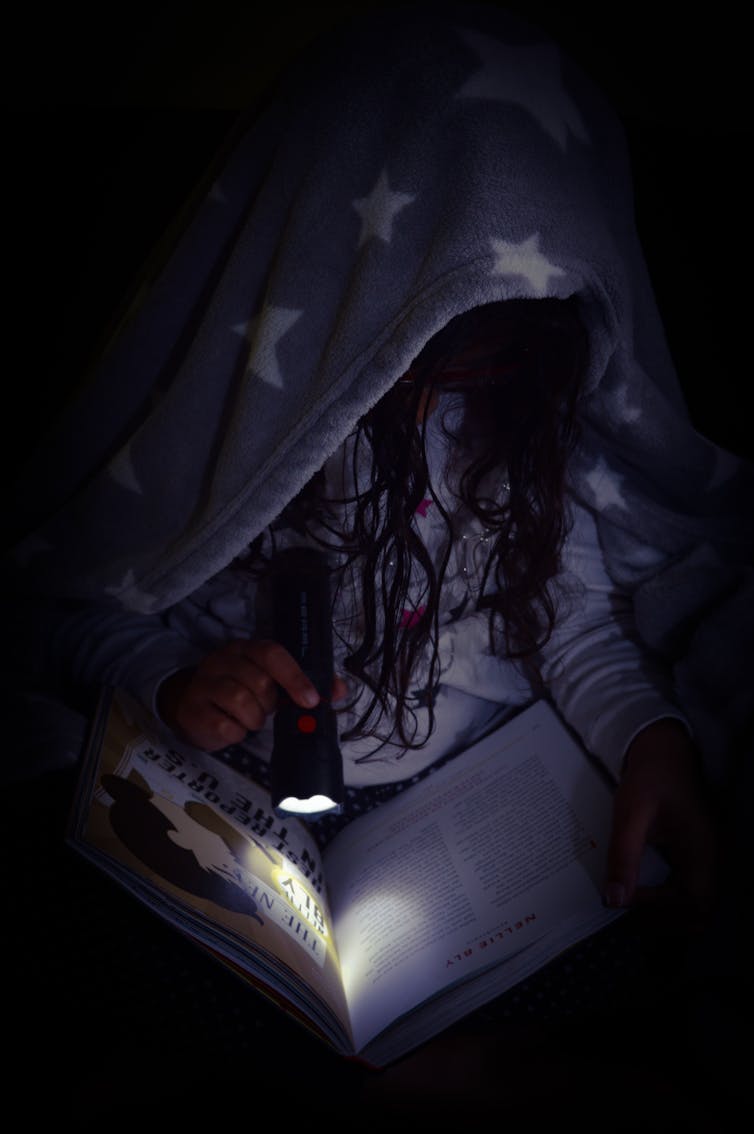5 story senses and the art of writing for children
- Written by Sean Williams, Lecturer, Flinders University
At the heart of every adult writer lies a novel they adored as a child. No wonder then so many try to write for kids themselves. So why do they often fail?
Perhaps it’s because, on the whole, adults are taught to write for adults, utilising the full power of the five regular senses – sight, sound, touch, taste, and smell – to evoke meaning in even the most trivial of everyday events.
This approach is less successful with younger readers, for one very simple reason: there are five other senses that speak more potently to them.
Consciously or unconsciously, successful writers use these other senses to hook young readers (and open their parents’ wallets) in ways that seem almost magical.
It’s not magical at all, though.
Here are the five story senses guaranteed to stir a child’s literary heart.
1. Humour
Everyone with kids in their lives knows the horror of a joke compendium: the same old gags we learned in childhood, repeated over and over, quickly lose appeal.
The only thing worse would be forcing kids to stop telling them.
 Humour is the key to anyone’s heart.
Ben White/Unsplash, CC BY
Humour is the key to anyone’s heart.
Ben White/Unsplash, CC BY
It is easy to forget jokes are hilarious the first time around, and funny doesn’t mean trivial. Humourist Terry Pratchett understood a reader can learn just as much from a book that provokes a laugh as from one that doesn’t - and he was the bestselling UK author until J K Rowling came along.
Make a kid laugh and they’ll be a fan forever.
2. Justice
People develop a sense of fairness at a very early age, some studies suggesting it kicks in as early as 12 months. Who doesn’t love seeing justice done? For this reason, crime fiction is one of the biggest genres in the world – and kids are no different to adult readers.
Read more: Young morals: can infants tell right from wrong?
Few people would seriously suggest a sense of justice should be drummed out of children, but it can definitely be quashed when parental authority is under assault. Kids therefore are constantly on the pointy end of injustice, or feel they are.
This is why Rowling takes Harry back to the despicable Dursleys at the end of every book. Exploiting the sense of justice ensures her readers never lose interest.
3. Belonging
The one genre bigger than crime is romance.
While not all kids will be into romantic love (The Princess Bride notwithstanding), they will have a keen sense of belonging. They have friends, family and pets in their lives, and stories engaging this sense helps them navigate these relationships, particularly when loss or denial is involved.
Mark Twain’s The Adventures of Tom Sawyer remains a classic because, beneath everything else, it is a story about a young boy finding his place in the world, and in people’s hearts.
4. Danger
The Adventures of Tom Sawyer also contains scenes of terrible peril, as does Doctor Who. Children love to be scared by fictional stories because in life, alas, many find themselves in very real peril. Fiction gives kids a safe way to activate their sense of danger, and maybe learn a life-saving strategy or two, as well.
 Fiction is a safe way for children to explore danger.
Anuja Mary Tilj/Unsplash, CC BY
Fiction is a safe way for children to explore danger.
Anuja Mary Tilj/Unsplash, CC BY
The sense of danger is so fundamental to our psyche that it might actually be hardwired into us: the Moro, or “startle”, reflex is innate in healthy newborns.
There are limits, of course, but no one ever ever lost a young audience by trying to push them. (Parents are a different matter.)
5. Wonder
Everyone will have some of these senses, but some people won’t have all of them. This sense, my personal favourite, is very hard to explain to someone who doesn’t possess it. It is the engine that drives fantasy and science fiction. When something makes a reader go “wow”, their sense of wonder has been engaged.
Kids understand this sense very well, because everything to them is big and new: just note how many synonyms they have for “awesome”. While it too may be drummed out of young people as they age, it can be revived under particular circumstances. Reading JRR Tolkien’s The Lord of the Rings has been one for many avid readers.
It is easy to forget The Hobbit predated this work, and, although no less awe-some, it was originally created for children.
These senses are just the start
Hefty doses of humour, justice, belonging, danger, and wonder will go some way towards compensating for deficiencies in other aspects of the writing craft. Children, and many adults, will often choose a good story badly written over a well-made dud.
This formula will also work for other media. Take Star Wars and Avengers movies, for example: both rich in the five story senses, and both part of the Disney stable, home to many other examples.
Any author wanting to pen a bestseller could do worse than start here. As always, though, there is no substitute for hard work - and luck.
Authors: Sean Williams, Lecturer, Flinders University




